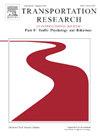Crossing the line: Impact of pedestrian group behavior on individual crossing decisions in AV interactions
IF 3.5
2区 工程技术
Q1 PSYCHOLOGY, APPLIED
Transportation Research Part F-Traffic Psychology and Behaviour
Pub Date : 2025-02-01
DOI:10.1016/j.trf.2025.01.020
引用次数: 0
Abstract
Research and development in automated driving are steadily progressing, with an increasing number of vehicles equipped with these systems participating in road traffic. Ensuring safe and robust interactions between automated vehicles and other road users is essential, especially in urban environments where interactions between vehicles and groups of pedestrians are common. Literature shows that external human–machine interfaces on automated vehicles might serve as a possible solution for such communication. Pedestrian groups have not been adequately considered in research on road crossings in front of automated vehicles equipped with external human–machine interfaces. This study investigates whether and how the behavior of a pedestrian group affects a single pedestrians behavior and perception of crossing in front of an automated vehicle equipped with an external human–machine interface. A virtual reality study with 44 participants revealed that pedestrians adjust their crossing behavior based on the behavior of others, leading to both improved efficiency and potential safety risks during crossings. Subjective measures revealed increased trust in automated vehicles with repeated exposure. However, trust remained essentially unchanged across different behaviors of the pedestrian group. After the experiment, almost three-quarters of the participants reported a subjective influence of the pedestrian group. Objectively, participants crossed earlier and more confidently when the group began to cross the street, improving efficiency in scenarios where the automated vehicle stopped. The same behavior raises safety concerns in scenarios where the automated vehicle is about to pass, as participants follow the pedestrian group early. These findings highlight the need for automated vehicle communication systems to consider group dynamics to ensure safety and efficiency.
越界:行人群体行为对自动驾驶汽车交互中个体越界决策的影响
自动驾驶的研究和开发正在稳步推进,越来越多的车辆配备了这些系统参与道路交通。确保自动驾驶车辆与其他道路使用者之间安全和稳健的互动至关重要,特别是在车辆与行人群体之间互动常见的城市环境中。文献表明,自动驾驶汽车上的外部人机界面可能是这种通信的可能解决方案。在配备外部人机接口的自动驾驶车辆前的道路交叉口研究中,行人群体没有得到充分的考虑。本研究调查了在配备外部人机界面的自动车辆前,行人群体的行为是否以及如何影响单个行人的行为和对过马路的感知。一项有44名参与者参与的虚拟现实研究显示,行人会根据他人的行为调整自己的过马路行为,从而提高了过马路的效率,同时也带来了潜在的安全风险。主观测量显示,反复接触自动驾驶汽车会增加人们对其的信任。然而,在不同的行人行为中,信任基本保持不变。实验结束后,近四分之三的参与者报告了行人组的主观影响。客观地说,当小组开始过马路时,参与者更早、更自信地过马路,在自动车辆停车的情况下提高了效率。在自动驾驶汽车即将通过的场景中,同样的行为引发了安全担忧,因为参与者很早就跟在行人后面。这些发现强调了自动车辆通信系统需要考虑群体动力学以确保安全和效率。
本文章由计算机程序翻译,如有差异,请以英文原文为准。
求助全文
约1分钟内获得全文
求助全文
来源期刊
CiteScore
7.60
自引率
14.60%
发文量
239
审稿时长
71 days
期刊介绍:
Transportation Research Part F: Traffic Psychology and Behaviour focuses on the behavioural and psychological aspects of traffic and transport. The aim of the journal is to enhance theory development, improve the quality of empirical studies and to stimulate the application of research findings in practice. TRF provides a focus and a means of communication for the considerable amount of research activities that are now being carried out in this field. The journal provides a forum for transportation researchers, psychologists, ergonomists, engineers and policy-makers with an interest in traffic and transport psychology.

 求助内容:
求助内容: 应助结果提醒方式:
应助结果提醒方式:


